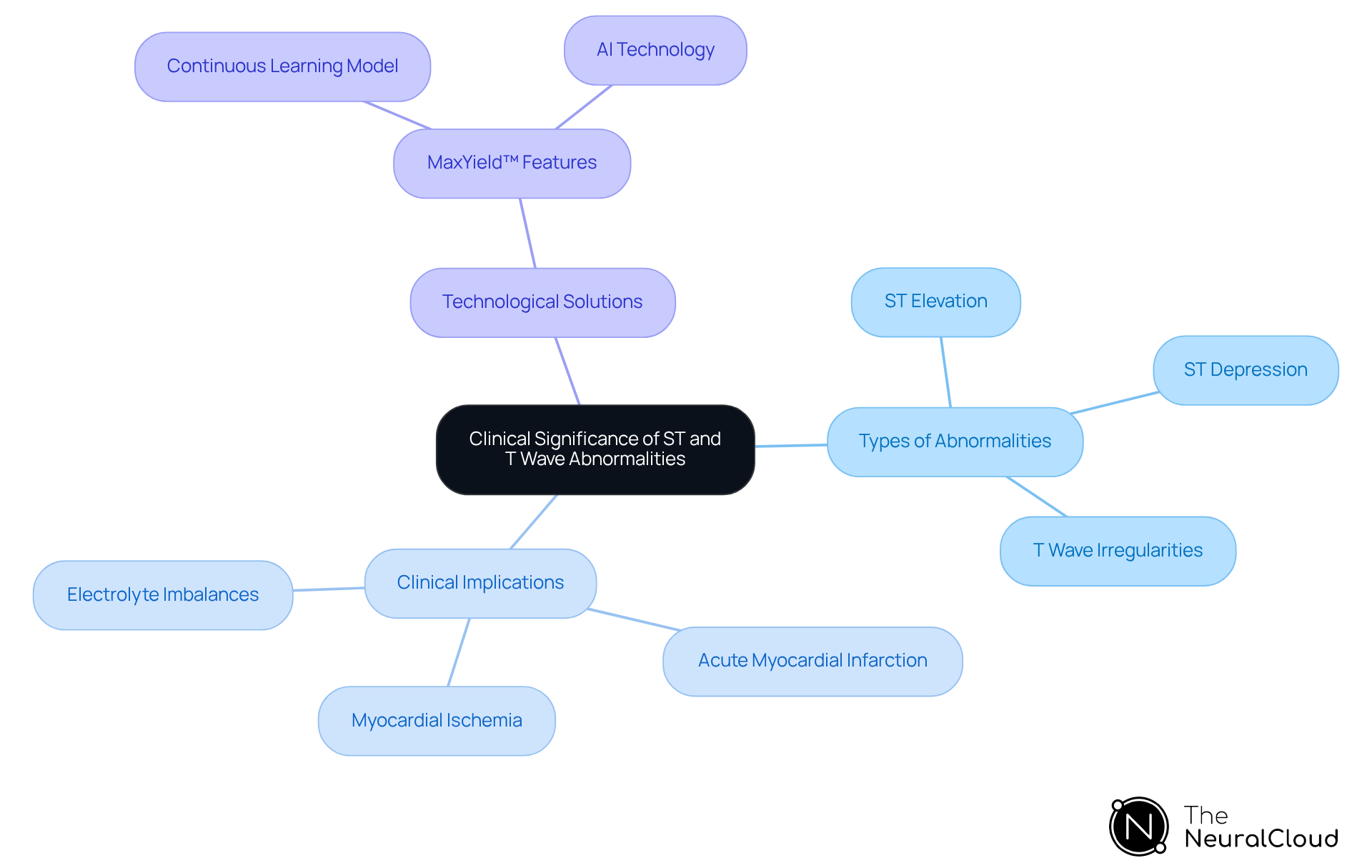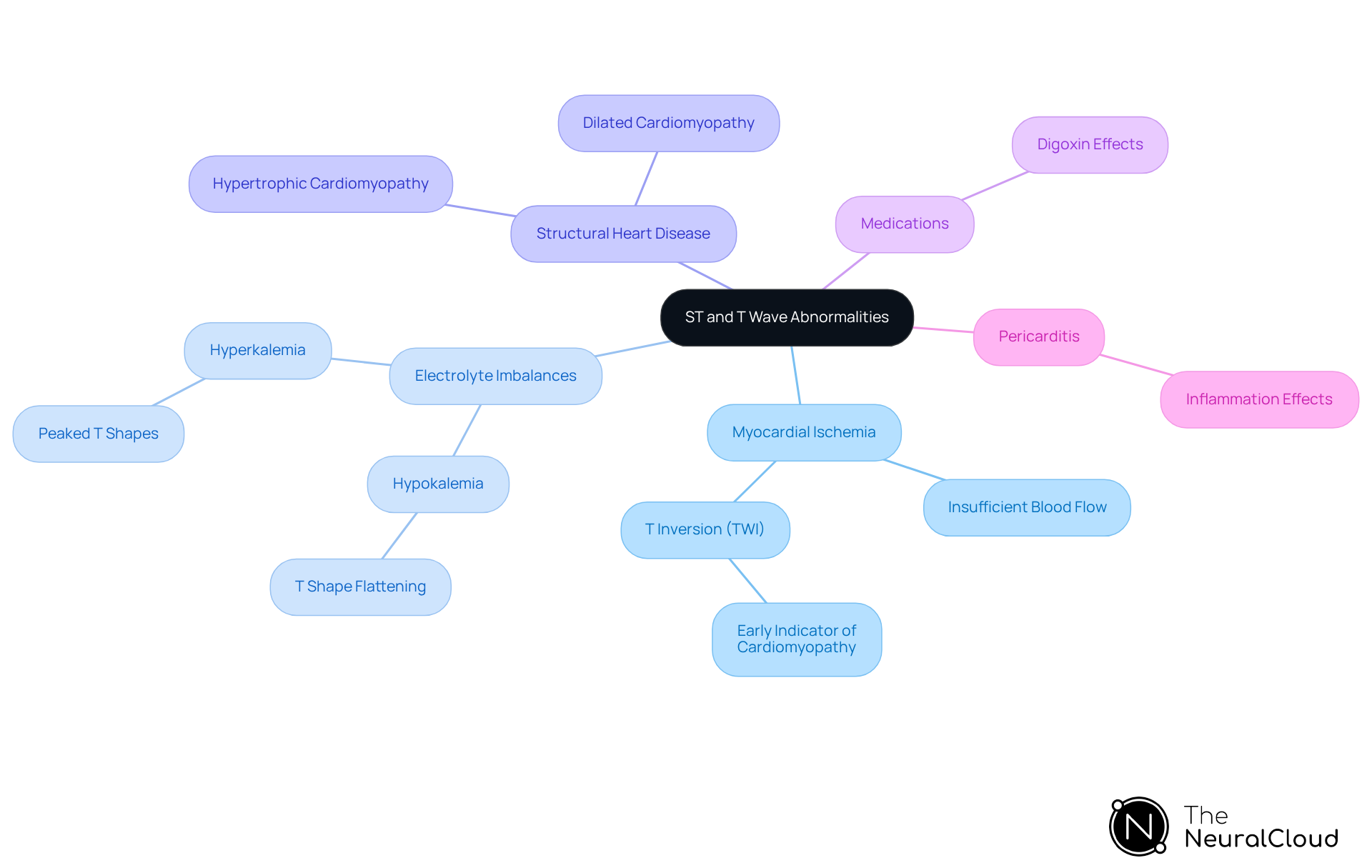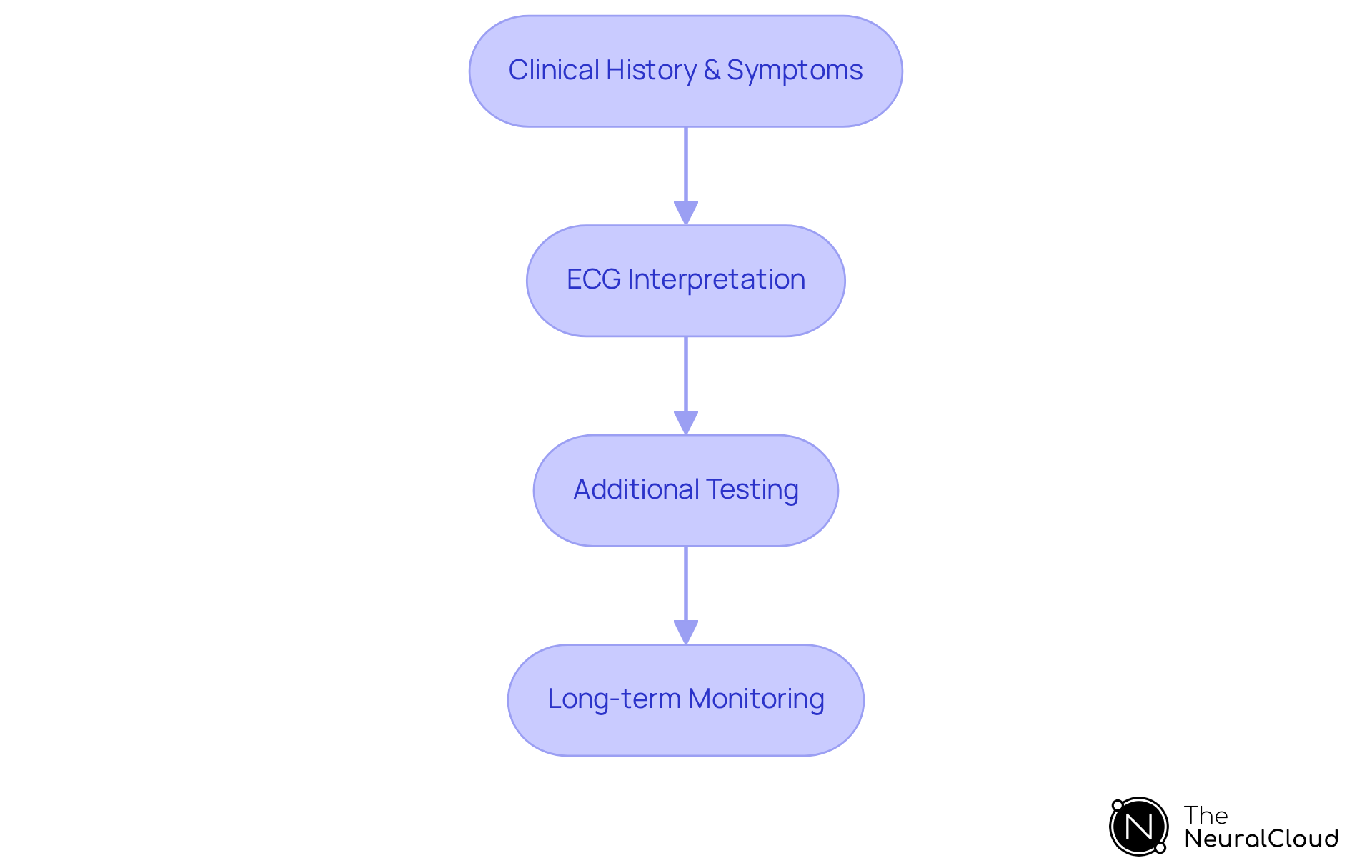Overview
The article examines the importance of ST and T wave abnormalities in electrocardiograms (ECGs) and their implications for clinical practice, particularly in the development of advanced ECG interpretation algorithms. These abnormalities are critical indicators of various cardiac conditions, including ischemia and myocardial infarction. Technologies like Neural Cloud Solutions' MaxYield™ platform enhance the accuracy and efficiency of ECG analysis through advanced AI and noise filtering techniques.
In the realm of ECG analysis, healthcare professionals face significant challenges. The MaxYield™ platform addresses these issues by leveraging cutting-edge technology to provide clear, actionable insights from ECG data. Key features of the platform include:
- Sophisticated algorithms that improve detection rates of abnormalities
- Ability to filter out noise, which can obscure critical signals
The advantages of utilizing the MaxYield™ platform are substantial for healthcare providers. By enhancing the accuracy of ECG interpretation, the platform not only aids in timely diagnosis but also improves patient outcomes. With its user-friendly interface, healthcare professionals can easily navigate the system, leading to more efficient workflows and better resource allocation.
In conclusion, the integration of advanced technologies like the MaxYield™ platform into ECG analysis represents a significant advancement in cardiac care. By providing precise interpretations and reducing the potential for diagnostic errors, it ultimately supports healthcare professionals in delivering high-quality patient care.
Introduction
Alterations in the ST and T waves of an electrocardiogram (ECG) can reveal critical insights into a patient's cardiac health, often serving as early indicators of serious conditions. Understanding these abnormalities is not merely an academic pursuit; it has significant implications for developers of advanced ECG interpretation tools that enhance clinical decision-making. As the healthcare industry increasingly relies on technology to analyze complex data, a pressing challenge emerges: how can developers ensure their algorithms accurately identify these vital irregularities in real-time? This question underscores the need for innovative solutions that can effectively address the complexities of ECG analysis.
Define ST and T Wave Abnormalities in ECG
ST and T wave abnormality signify departures from the typical shape of the ST area and T form on an electrocardiogram (ECG). The ST portion signifies the period between ventricular depolarization and repolarization, while the T crest represents the repolarization of the ventricles. Anomalies can present as:
- ST elevation
- ST depression
- T inversion
- Flattening
- Peaking
These changes can signal various cardiac conditions, including ischemia, electrolyte imbalances, and structural heart diseases. For example, ST segment elevation is frequently associated with myocardial infarction, with approximately 700,000 first-time myocardial infarctions occurring annually in the United States. Conversely, T wave inversions may indicate underlying ischemic heart disease or other cardiac pathologies, with studies showing that T wave inversion in leads other than V is linked to a threefold increase in the risk of sudden cardiac death (SCD).
Understanding these definitions is crucial for developers aiming to enhance ECG interpretation algorithms, as accurate identification of ST and T wave abnormality is essential for timely clinical decision-making. Recent studies have highlighted the prevalence of ST segment elevation and depression in various patient populations, underscoring the need for effective monitoring and analysis. For example, in individuals with left ventricular hypertrophy (LVH), ST and T alterations are seen in about 70% of instances, indicating modified repolarization.
Neural Cloud Solutions' MaxYield™ platform addresses these challenges by leveraging advanced AI technology and a continuous learning model to enhance ECG analysis efficiency. By automating the labeling and interpretation of ECG signals, MaxYield™ transforms noisy recordings into detailed insights, delivering beat-by-beat analysis of 200,000 heartbeats in less than 5 minutes. This ability not only enhances the precision of recognizing ST and T wave abnormality but also aids in assured clinical decision-making.
Alterations in the ST phase and T patterns, known as ST and T wave abnormality, can act as early indicators of underlying cardiovascular conditions, highlighting the significance of observing these irregularities for timely identification of heart problems. Real-world instances of ST elevation and depression in clinical environments further demonstrate the significance of these irregularities in diagnosing and managing cardiac conditions.

Explore Clinical Significance of ST and T Wave Abnormalities
The clinical significance of ST and T wave abnormality is paramount, serving as critical indicators of underlying cardiac conditions. For instance, ST elevation is a definitive indicator of acute myocardial infarction, necessitating prompt medical intervention. In contrast, ST segment depression often suggests myocardial ischemia or other cardiac stressors. T wave irregularities, including inversion or flattening, can signify various issues such as electrolyte imbalances—hypokalemia or hyperkalemia—and structural heart conditions. Identifying ST and T wave abnormality and other irregularities is crucial for healthcare providers, as they guide treatment choices and risk assessment.
Understanding these clinical implications is vital for developers, particularly in creating algorithms that identify these irregularities and contextualize their significance. This enhances the effectiveness of ECG analysis tools in clinical practice. The MaxYield™ platform from Neural Cloud Solutions leverages cutting-edge AI technology to transform lengthy and noisy ECG recordings into clean, crisp signals, significantly improving analysis efficiency. Key features of MaxYield™ include a Continuous Learning Model that ensures the accuracy and efficiency of ECG interpretation evolve with each use, specifically addressing challenges like physiological variability and signal artifacts.
Testimonials from healthcare experts highlight the platform's efficiency in precisely recognizing T variations, which are especially indicative of cardiovascular mortality. This underscores the need for advanced ECG analysis platforms like MaxYield™ to accurately identify and interpret these critical signals. By enhancing workflow and patient outcomes, MaxYield™ provides a significant advantage for healthcare professionals, ensuring they can deliver timely and effective care.

Identify Common Causes of ST and T Wave Abnormalities
ST and T wave abnormality can arise from a variety of conditions, ranging from benign to critical. Key causes include:
-
Myocardial Ischemia: Insufficient blood flow to the heart muscle can result in ST segment changes, either depression or elevation, depending on the ischemic event's severity and duration. Recent studies suggest that T inversion (TWI) across multiple regions is a significant early indicator of underlying cardiomyopathy, particularly in younger individuals.
-
Electrolyte Imbalances: Disorders such as hypokalemia (low potassium) can lead to T shape flattening or inversion, while hyperkalemia (high potassium) may cause peaked T shapes, both of which are critical for accurate ECG interpretation and can result in ST and T wave abnormality.
-
Structural Heart Disease: Conditions such as hypertrophic cardiomyopathy and dilated cardiomyopathy frequently display unusual T shape morphology, which may indicate ST and T wave abnormality, necessitating thorough examination to distinguish between harmless variations and pathological alterations.
-
Medications: Certain pharmaceuticals, including digoxin, can modify T wave appearance, leading to an ST and T wave abnormality that results in distinctive changes on the ECG requiring recognition for proper diagnosis.
-
Pericarditis: Inflammation of the pericardium can lead to ST and T wave abnormality across multiple leads, which is essential for clinicians to identify in order to manage potential complications effectively.
Grasping these factors is essential for developers, as it guides the creation of algorithms able to provide differential diagnoses based on identified irregularities. The incorporation of Neural Cloud Solutions' MaxYield™ platform enhances this process by utilizing advanced noise filtering and unique signal recognition to improve the accuracy and efficiency of ECG analysis.
For example, the platform can automatically tag T variations, enabling faster recognition and action. This capability ultimately enhances patient outcomes by facilitating timely and accurate clinical decisions. As Dr. Finocchiaro noted, "ECGs have the power to detect signs of heart disease that would otherwise go unnoticed," reinforcing the significance of these analyses in conjunction with the MaxYield™ platform.

Discuss Diagnostic Approaches for ST and T Wave Abnormalities
Diagnostic methods for ST and T wave abnormality encompass a systematic combination of clinical assessment and advanced imaging techniques. This approach addresses the challenges faced in ECG analysis by ensuring comprehensive evaluations that lead to informed clinical decisions.
Clinical History and Symptoms: The first step involves collecting a detailed patient history and assessing symptoms such as chest pain, shortness of breath, or palpitations. This foundational information provides essential context for accurately interpreting ECG findings, particularly in relation to ST and T wave abnormality.
ECG Interpretation: A meticulous examination of the ECG is crucial, focusing on the shape of the ST segment and T component, especially in detecting any ST and T wave abnormality, as well as their connections to other ECG elements. With Neural Cloud Solutions' MaxYield™, developers can enhance ECG interpretation through advanced noise filtering and unique signal recognition. This technology enables precise labeling of critical data, even in recordings with significant noise and artifact, with the data conveniently tabulated in CSV format for seamless integration into existing workflows.
Additional Testing: Following initial ECG findings, further testing may be warranted. This could include cardiac biomarkers, echocardiography, or stress testing to evaluate cardiac function and ischemia, ensuring a thorough assessment of the patient's condition.
Long-term Monitoring: In some instances, continuous ECG monitoring—such as Holter monitoring—may be necessary to capture transient abnormalities that could indicate underlying cardiac issues. MaxYield™ streamlines this process by rapidly isolating ECG waves from recordings affected by baseline wander and muscle artifact, thereby salvaging previously obscured sections of lengthy recordings.
By understanding these diagnostic approaches, developers can refine their algorithms to better assist clinicians in making informed decisions based on detailed ECG analysis that includes identifying ST and T wave abnormality. The integration of computerized ECG interpretation (CEI) tools, particularly those powered by MaxYield™, significantly enhances diagnostic accuracy and clinician confidence. Studies indicate that CEI interpretation is associated with a 15% improvement in accuracy and a 52-second decrease in interpretation time per ECG, underscoring its effectiveness in clinical practice.

Conclusion
Understanding ST and T wave abnormalities is essential for effective cardiovascular care, as these irregularities serve as critical indicators of underlying heart conditions. By accurately identifying these abnormalities on an electrocardiogram (ECG), healthcare providers can make informed decisions that significantly impact patient outcomes.
The article highlights the various types of ST and T wave abnormalities, such as:
- ST elevation
- ST depression
- T wave inversion
along with their clinical significance. It emphasizes the importance of advanced diagnostic techniques and tools, like Neural Cloud Solutions' MaxYield™ platform, which enhances ECG analysis through AI-driven technology. This platform not only improves the precision of identifying irregularities but also streamlines the diagnostic process, ensuring timely interventions for patients at risk of serious cardiac events.
Ultimately, the integration of advanced ECG interpretation tools is crucial in the ongoing effort to improve heart health outcomes. As the medical community continues to embrace technology that enhances diagnostic accuracy and efficiency, the significance of recognizing ST and T wave abnormalities cannot be overstated. By prioritizing the identification and analysis of these critical signals, healthcare professionals can better safeguard their patients against the potentially devastating consequences of cardiovascular disease.
Frequently Asked Questions
What do ST and T wave abnormalities signify in an ECG?
ST and T wave abnormalities indicate departures from the typical shape of the ST area and T form on an electrocardiogram (ECG), which can signal various cardiac conditions.
What do the ST segment and T wave represent in an ECG?
The ST segment represents the period between ventricular depolarization and repolarization, while the T wave represents the repolarization of the ventricles.
What are some types of ST and T wave abnormalities?
Some types of ST and T wave abnormalities include ST elevation, ST depression, T inversion, flattening, and peaking.
What conditions can ST and T wave abnormalities indicate?
These abnormalities can indicate conditions such as ischemia, electrolyte imbalances, and structural heart diseases.
How is ST segment elevation related to myocardial infarction?
ST segment elevation is frequently associated with myocardial infarction, with around 700,000 first-time myocardial infarctions occurring annually in the United States.
What does T wave inversion indicate?
T wave inversions may indicate underlying ischemic heart disease or other cardiac pathologies, with a significant increase in the risk of sudden cardiac death linked to T wave inversion in leads other than V.
Why is understanding ST and T wave abnormalities important for developers?
Understanding these definitions is crucial for developers aiming to enhance ECG interpretation algorithms, as accurate identification is essential for timely clinical decision-making.
How prevalent are ST and T wave alterations in patients with left ventricular hypertrophy (LVH)?
In individuals with left ventricular hypertrophy (LVH), ST and T alterations are seen in about 70% of instances.
What technology does Neural Cloud Solutions' MaxYield™ platform use for ECG analysis?
MaxYield™ utilizes advanced AI technology and a continuous learning model to enhance ECG analysis efficiency and automate the labeling and interpretation of ECG signals.
How does MaxYield™ improve the analysis of ECG signals?
MaxYield™ transforms noisy recordings into detailed insights, delivering beat-by-beat analysis of 200,000 heartbeats in less than 5 minutes, enhancing the precision of recognizing ST and T wave abnormalities.
Why are ST and T wave abnormalities significant in clinical environments?
Alterations in the ST phase and T patterns can act as early indicators of underlying cardiovascular conditions, highlighting their significance for timely identification and management of heart problems.






